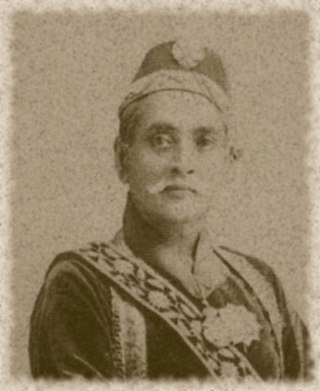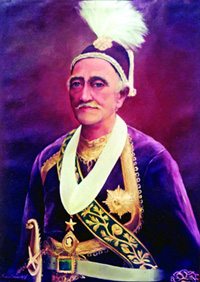
The Bangabhaban is the official residence and principal workplace of the President of Bangladesh, located on Bangabhaban Road, and short road connecting Dilkusha Avenue, Dhaka. It is surrounded by the Bangabhaban Gardens.

Dhaka (Dacca) is a modern megacity with origins dating from 500 BC to 200 BC. The history of Dhaka region begins with the existence of urbanised settlements that were ruled by Gupta Empire, Gauda Kingdom, Pala Empire and Chandra dynasty before passing to the control of the Sena dynasty in the 10th century CE. After the reign of Sena dynasty, the region was ruled by the Hindu Deva dynasty of Bikrampur.

Shahbagh is a major neighbourhood and a police precinct or thana in Dhaka, the capital and largest city of Bangladesh. It is also a major public transport hub. It is a junction between two contrasting sections of the city—Old Dhaka and New Dhaka—which lie, respectively, to its south and north. Developed in the 17th century during Mughal rule in Bengal, when Old Dhaka was the provincial capital and a centre of the flourishing muslin industry, it came to neglect and decay in early 19th century. In the mid-19th century, the Shahbagh area was developed as New Dhaka became a provincial centre of the British Raj, ending a century of decline brought on by the passing of Mughal rule.

Nawab Bahadur Sir Khwaja Ahsanullah KCIE was the third Nawab of Dhaka. He was notable for his philanthropic works in Bengal, most notably his donations to the present Bangladesh University of Engineering and Technology. He also authored books in Persian and Urdu under the pen name of Shaheen. The palace Ahsan Manzil is named after him by his father Khwaja Abdul Ghani.

Nawab Sir Khwaja Salimullah Bahadur was the fourth Nawab of Dhaka and one of the leading Muslim politicians during the British rule in India.

Nawab Bahadur Sir Khwaja Abdul Ghani was the second Nawab of Dhaka and the first to assume the title of Nawab as hereditary, recognized by the British Raj.

Khwaja Alimullah was the first Nawab of Dhaka. He was the founder of the Dhaka Nawab family.

Nawab Khwaja Habibullah Bahadur was a politician from East Bengal, soldier, social worker, and the fifth Nawab of Dhaka. He was the son of Nawab Sir Khwaja Salimullah Bahadur. Under Habibullah's rule, the Dhaka Nawab Estate went into decline until its actual relinquishment in 1952 by the East Pakistan Estates Acquisition Act.

The Nawab of Dhaka, originally spelt in English Nawab of Dacca, was the title of the head of one of the largest Muslim zamindar in British Bengal and Assam, based in present-day Dhaka, Bangladesh. The title of nawab, similar to the British peerage, was conferred upon the head of the family by Queen Victoria as a recognition of the first Nawab's loyalty and contribution to the social welfare activities.

The Port of Dhaka is a major river port on the Buriganga River in Dhaka, the capital and largest city of Bangladesh. The port is located in the southern part of the city. It is Bangladesh's busiest port in terms of passenger traffic. The port has services to most of the districts of Bangladesh. In 2013, a container terminal opened 20 kilometres (12 mi) from the city to handle ocean-going ships. Along with Barisal, Chandpur and Narayanganj; the Dhaka port handled 53 million tonnes of cargo and 22 million passengers in 2013–14.

Tourism in Bangladesh includes tourism to World Heritage Sites, historical monuments, resorts, beaches, picnic spots, forests, tribal people, and wildlife of various species. Activities for tourists include angling, water skiing, river cruising, hiking, rowing, yachting, beachgoing and sea bathing.
Nawab Major Khwaja Hassan Askari was the sixth and last Nawab of Dhaka. He was born at the Ahsan Manzil Palace in Dhaka. He was the eldest son of Nawab Habibullah Bahadur and Shahryar Begum. He became the Nawab of Dhaka after his father's death in 1958.

Farashganj is a neighborhood in Dhaka, Bangladesh. The name comes from the Bengali word for French which is Forashi and ganj, meaning market-town.
Buckland Bund is a historically significant architectural creation situated by the Buriganga river bank of Old Dhaka, Bangladesh. It was constructed by Charles Thomas Buckland in 1864 who was the commissioner of Dhaka during that period.

The architecture of Dhaka is a confluence of many architectural styles. From the Sena temples built by Ballal Sen, to the Mughal architecture of the Mughals, to the Indo-Saracenic style of the colonial era, to 20th century steel and chrome of skyscrapers. Dhaka has a colonial core in the river port area, surrounded by progressively newer areas as one travels away from the Buriganga, punctuated with old temples, churches and mosques.

The Lalbagh Fort is a fort in the old city of Dhaka, Bangladesh. Its name is derived from its neighbourhood Lalbagh, which means Red Garden. The term Lalbagh refers to reddish and pinkish architecture from the Mughal period. The original fort was called Fort Aurangabad. Its construction was started by Prince Muhammad Azam Shah, who was the son of Emperor Aurangzeb and a future Mughal emperor himself. After the prince was recalled by his father, the fort's construction was overseen by Shaista Khan. The death of Shaista Khan's daughter Pari Bibi resulted in a halt to the construction process, apparently due to Shaista Khan's superstition that the fort brought bad omen. Pari Bibi was buried inside the fort.
Meherbanu Khanam was an artist and noblewoman in Bengal of kashmiri ancestry. She was the daughter of Nawab Sir Khwaja Ahsanullah Bahadur and his wife Nawab Begum Kamrunnesa.
Shaykh Malik, popularly known as Pir Yemeni was a pir who lived in Bengal.
The Dacca Bank was a bank founded in 1846 in Dhaka, in the then British India. The bank was the thirty second oldest bank in India. It is the very first private bank founded in the present day country of Bangladesh.

Khwaja Hafizullah Kashmiri (1735–1815), also known as Moulavi Hafizullah, was an 18th-century merchant of Kashmiri origin. He and his nephew, Khwaja Alimullah, were the founding members of the Dhaka Nawab Estate, the largest zamindari held by any landholder in Eastern Bengal during the British colonial period.





















